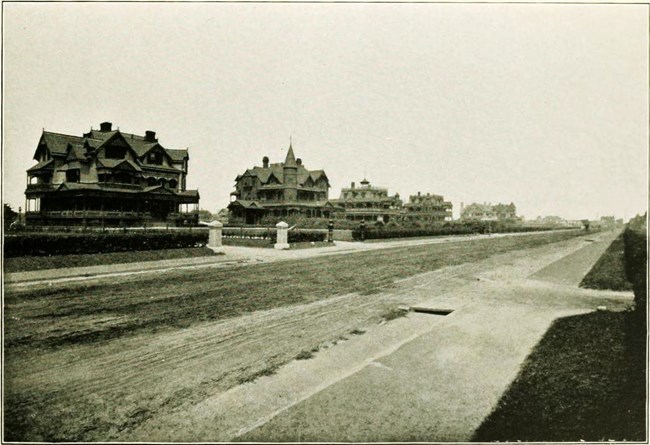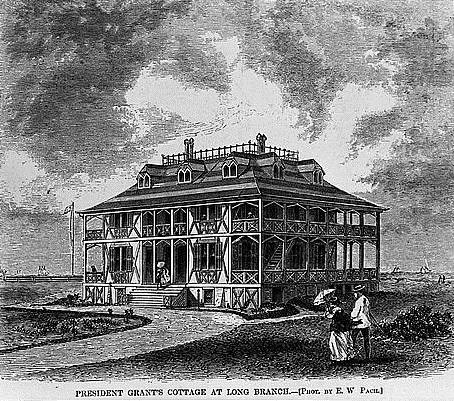Last updated: October 28, 2020
Article
Long Branch, New Jersey: The Resort Town that Hosted President Garfield

Many people who know something about President Garfield’s assassination assume that he died in the White House. He did not. He died at Elberon, New Jersey (September 19, 1881). How did that happen? Why did he die in New Jersey, and how did he get there? Why was he taken to Elberon?
Elberon, New Jersey is located on the Atlantic coast and is an “unincorporated” part of Long Branch, a once-famous resort town which was the place to go for cool ocean breezes and no “malaria-causing mosquitos.” First Lady Mary Todd Lincoln visited the town in August 1861, at the suggestion of Dr. William A. Newell, the Lincoln family physician. Mary Lincoln’s visit was followed in all of the national papers and spearheaded Long Branch’s rise as travel destination for the rich and famous.

Long Branch had long been a “summer colony” for nineteenth century actors and actresses, many of whom owned homes there. Among the famous performers of the day who spent time at Long Branch were Edwin and Joseph Booth, (brothers of John Wilkes Booth) and Edwin Forrest. Lillian Russell, Lily Langtry, and Diamond Jim Brady all vacationed in the town. Buffalo Bill’s associate, Nate Salsbury, the brains behind his Wild West Shows, owned a home in Long Branch. America’s first clown star, Dan Rice, was born in Long Branch and returned there to live with his family after he retired from his circus days.
General Winfield Scott regularly summered at Long Branch for many years. Civil War General Thomas Eckert lived and died there, and George Pullman (of the Pullman Car Company) enjoyed staying at this beach resort. Several wealthy local residents pooled their money and bought President Grant a summer home in 1869, and thus started Long Branch’s days as the nation’s “Summer Capital.”

Library of Congress
The seashore resort at Long Branch was familiar to President Garfield, a man who had always found the ocean comforting. When his wife Lucretia needed to recuperate after contracting malaria in the White House, it was to the Elberon Hotel that they retreated in mid-June 1881. Garfield’s belief in the wholesomeness of the seashore is seen in his diary entry for Sunday, June 19: “Passed a restful day with manifest betterment in her [Lucretia’s] strength…The work and worry of Washington seem very far away and I rest in the large silence of the sea air. I have always felt the ocean was my friend and the sight of it brings rest and peace.”
At that time, Grant and his wife had been displaced from their cottage in nearby Long Branch and were using their son Fred’s cottage across the way from Elberon Hotel. “Grant was mortified,” according to Ken Ackerman, author of Dark Horse: The Surprise Election and Political Murder of James A. Garfield. Garfield and Grant had never been close politically or personally, and Grant resented the fact that Garfield, and not he, had been nominated for president in 1880.

Published in Entertaining a Nation, 1940
Grant went to the President’s hotel one evening when the Garfields were dining. He did not speak to the President, and people noticed. Later, when Grant did speak briefly to Garfield at a reception held for the President, Garfield saw Grant’s action as a “tardy recognition of the respect due to the office he once held.”
Mrs. Garfield continued to recuperate at Elberon as July followed June. It was there that she received word of the shooting of her husband on July 2nd. She returned to the White House to care for her wounded husband. Over the next two months the President’s condition deteriorated. At the beginning of September, Garfield demanded to be removed from the White house. It was decided that his home in Mentor, Ohio was too distant. His love for the ocean became the deciding factor in his journey to the New Jersey shore.

Frank Leslie’s Illustrated Newspaper, September 24, 1881, Library of Congress.
He was taken by a special train cushioned with mattresses to lessen the rocking motion as it sped along the rails. A special track was laid from the depot at Long Branch to the Francklyn Cottage – a twenty room mansion, in fact – and Garfield’s car was pushed by twenty or more men to its door. President Garfield is reported to have said, “Thank God, it is good to be here,” when he finally arrived and could enjoy the salt air and sounds of the ocean waves.
Long Branch hosted presidents before and after Garfield, including Grant, Rutherford B. Hayes, Chester Arthur, Benjamin Harrison, William McKinley, and Woodrow Wilson. There is a “Church of the Presidents” in Long Branch, where all seven worshipped, and “Seven Presidents Beach” is named in honor of their visits.
A special thanks to Beth Woolley of Long Branch, New Jersey for supplying some of the content for this post.
Written by Alan Gephardt, Park Ranger, James A. Garfield National Historic Site July 2012 for the Garfield Observer.
